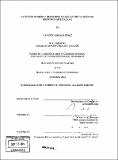Synthesis of highly quenching fullerene derivatives for biosensor applications
Author(s)
Pérez, Vanessa Virginia, 1981-
DownloadFull printable version (2.504Mb)
Other Contributors
Massachusetts Institute of Technology. Dept. of Chemistry.
Advisor
Timothy M. Swager.
Terms of use
Metadata
Show full item recordAbstract
This dissertation examines the synthesis of fullerene-based fluorescence quenchers for numerous biosensor applications. The Introduction describes the need for biosensors in our society, what they are and various biosensing schemes that are currently being worked on in our group. Chapter One describes the synthesis of a number of fullerene derivatives. In order to incorporate fullerene derivatives into biosensors, they need to posses a functional group that can be easily reacted with biomolecules. Two of the functional groups by which molecules are conjugated to biomolecules such as amino acids and proteins are amines and carboxylic acids. For this reason, we synthesized amine- and carboxy-containing C₆₀ that could then be conjugated to biomolecules. Chapter Two describes the steps taken towards the incorporation of these fullerene derivatives into biosensors. First, Stern-Volmer experiments were conducted to determine whether or not the fullerene derivatives would be good quenchers for our polymers. Second, a polymer with pendant fullerenes was made to determine whether or not there was an enhancement in the quenching as compared with the Stern-Volmer data. Third, the use of the biotin-streptavidin system to determine how well the fullerene derivatives would perform in a biosensor system is discussed.
Description
Thesis (S.M.)--Massachusetts Institute of Technology, Dept. of Chemistry, 2004. Vita. Includes bibliographical references.
Date issued
2004Department
Massachusetts Institute of Technology. Department of ChemistryPublisher
Massachusetts Institute of Technology
Keywords
Chemistry.